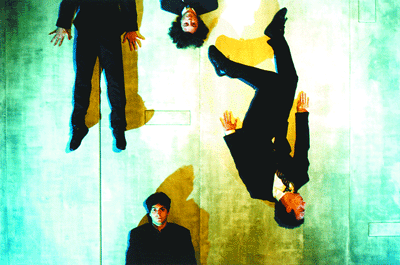A magical mix of motion, light and sound even grown-ups can admire
When I spied all those booster seats and sugar-charged kiddies playing patty-cake in the aisles, my instinct was to flee. But here I was, after all, at the New Victory Theater, famed pioneer of exceptional family-friendly fare and the 42nd Street renaissance just a decade ago, and on tonight’s bill was “Plan B,” an experimental “theatrical spectacle” that promised to redefine physical theater. So I gingerly took my seat.
The audience, perhaps the most diverse bunch you’ll ever see in a Broadway house, was about one-third children, their parents, couples on a date, college students, tourists who wandered in from the street, fashionistas, Chelsea boys and blue-haired grannies—all of varied races and economic strata.
However, unless the pint-sized patrons were given joysticks to manipulate the action onstage, I couldn’t imagine how they would sit still for 70 intermission-less minutes.
The quirky crowd was perfectly suited to the evening’s program, a pulsating, playful work that defies categorization—part-dance, part-circus, part-magic act, part-science experiment—and is 100 percent entrancing. With its rhythmic body gyrations and gravity-evading acrobatics, the piece conjures the Elizabeth Streb Company, renowned for ravaging the boundaries of traditional dance.
The four nimble young male performers, who’ve each done a serious stint in the circus, wear charcoal suits, white shirts and ties—reminiscent of the Argentine troupe, De La Guarda—which become rumpled and sweat-soaked in the course of the proceedings.
Did I mention there’s nary a word of dialogue nor a whit of conventional plot?
Making its U.S. debut, “Plan B” is a collaboration between the French group Compagnie 111 and Phil Soltanoff, known to New Yorkers as the Obie Award-winning director of “mad dog,” a radical theater troupe. The work navigates the edges of various disciplines, and that’s how Soltanoff likes it.
“Plan B is about the proximity of the mysterious to the everyday,” he says in the program notes.
As skilled as the performers are, the real star of the show is the 20-foot-square metallic plane that imposes a will of its own—and betrays a wicked sense of humor. Initially, the plane lies at a 45-degree angle, allowing the quartet to tentatively slide down, singularly and in combination, forming striking patterns. Later, secret compartments open, protrude and close, spurring more elaborate acts of derring-do.
As soon as the acrobats master this incline, the plane suddenly rises to 90 degrees to form a wall, a whole new challenge, and out come the Velcro suits and suction cups. Finally, the plane shifts again, to the floor, and the audience views the action on a life-size screen, with surprising results.
Now and again, the men juggle and bounce white rubber balls, a way of testing the patience of the temperamental landscape, and of each other. At times, they find themselves in some intimately precarious positions, which, I suspect, might have miffed a few parents had their costumes been traditional body-exposing leotards.
Surfaces are often punctuated by projected bursts of color and pattern—even a galaxy of stars.
This is theater in the abstract bordering on the absurd, with a pointed nod to Beckett. There are moments when the piece resembles a mammoth kinetic sculpture; other times it evokes a mute poetry, employing a vocabulary of motion instead of words.
According to Soltanoff, “Plan B” is about how playing often exposes “the potential of an object, a relationship with a space, which is at once mysterious and vital.” Not unlike, come to think of it, that game of patty-cake I witnessed coming in.
The electronic sound design (it hardly classifies as “music,” save for two brief appearances of an acoustic guitar) by Stephane Ley, whirrs and moans in time with the movement. Equally central to the work are the audible squeaks of hands and shoes, as the men scale and descend the plane, and the rhythmic thumps of the balls.
Perhaps most essential to the divine power of “Plan B” are the squeals of glee from enthralled (and extremely well-behaved) youngsters, a kind of giddy soundtrack that reminds us jaded, literal-minded grown-ups that something truly wondrous, and primal, is going on here.



































